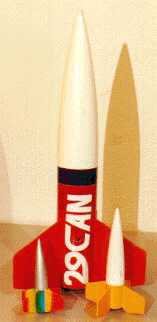| Manufacturer: | Scratch |
 "If
a bee is half a bee, it philosophically must half not be." --
The Token Python Reference, from The Contractual Obligation Album.
"If
a bee is half a bee, it philosophically must half not be." --
The Token Python Reference, from The Contractual Obligation Album.
Short rocket, long story. The original brainstorm (not quite a plan) was to extend a long motor like B2, I435, J350 or I200 up into the nose cone, with only enough body tube to hold the fins, and the recovery system packed around the motor. This has not worked out to my satisfaction yet, but I have this fun little concept-test rocket to show for it. It was yellow and white until I came across a cheap roll of 3/8" wide pro masking tape in a surplus store and went digging for a rocket to try it out on. A light coat of black, and Voila: Eric the 1/2A Bee.
 The
"29 Can" (right) never flew in this form. With 22" of Quantum tube added,
it did fly on an H238. The small rainbow rocket is dead. It is deceased.
It has passed on. It has gone to meet its maker. More precisely,
it has been hanging in a large tree since April 2001. Eric the Pre-Bee
is at lower right.
The
"29 Can" (right) never flew in this form. With 22" of Quantum tube added,
it did fly on an H238. The small rainbow rocket is dead. It is deceased.
It has passed on. It has gone to meet its maker. More precisely,
it has been hanging in a large tree since April 2001. Eric the Pre-Bee
is at lower right.
Nose Cone: I've done this with several different plastic nose cones. Eric is based on the long Estes PNC-50 used in the Athena and several other simple kits. It's a two-piece cone; the shoulder section is not used for this project. The forward centering ring projects from the body and fits into the base of the cone. If a one-piece cone is used, the shoulder is cut to about 1/4" and the centering ring recessed into the fin can to fit. In either case two 1/16" holes are drilled, 1/2" from the open end of the cone and 1/8" apart, to tie the shock cord to.
 Motor Mount
Tube: This is a piece of BT-5. Push it up into the nose cone
as far as it will go without forcing it. Mark the rim of the cone on the
tube, and mark again 1.25" farther down. Cut on the second mark.
Your motor mount tube will be about 3.75" long depending on the thickness
of the plastic. You may need to trim it after assembly for perfect
fit.
Motor Mount
Tube: This is a piece of BT-5. Push it up into the nose cone
as far as it will go without forcing it. Mark the rim of the cone on the
tube, and mark again 1.25" farther down. Cut on the second mark.
Your motor mount tube will be about 3.75" long depending on the thickness
of the plastic. You may need to trim it after assembly for perfect
fit.
Body Tube: This is a 1.25" long piece of BT-50 or equivalent, marked for four fins and one 1" long launch lug.
Centering Rings: This is a problem due to the reduced availability of builder's parts. You could cut them from thin plywood or heavy card stock, or build them up in layers of Kraft paper. I used, on each end, a 2050 ring, a 5/16" piece of BT-20, and a 520 ring, firmly glued together. The one at the aft end is flush with the end of both tubes. The one at the front fits into the BT-50 just far enough to center it and projects about 1/4" forward to center the nose cone; here at least you will need a standard Estes AR-2050 ring. A slot is cut in the aft 520 ring to accommodate an engine hook made from .047" music wire.
 Fins:
Cut four from 1/16" bass or balsa. Mine are slotted in to the MMT,
just because I was prototyping the bigger one, but that's hardly necessary
on this scale.
Fins:
Cut four from 1/16" bass or balsa. Mine are slotted in to the MMT,
just because I was prototyping the bigger one, but that's hardly necessary
on this scale.
Nose Weight: Essential! I used 1/2" of 3/16" diameter lead sinker wire, epoxied into the tip of the cone. Without nose weight this rocket flew arrow straight twice and unstable once. (That one was in front of the club.) The CG needs to be a bit ahead of the nose-body joint.
Recovery: 16" of 1/32" Kevlar® cord. Tied through the two holes in the side of the nose cone from the inside, and taped to the base of the motor mount tube with tough tape on the other. A small parachute or 1" x 8" streamer is attached to the shock cord within an inch of the motor mount tube end.
Prep: Insert the 1/2A3-4T or A3-4T motor. Stuff the forward portion of the MMT loosely with recovery wadding. Fold the chute or streamer very neatly into a flat package that wraps about 3/4 of the way around the MMT. Slip the nose cone on over this, and use a small stick to push the Kevlar® cord up into the base of the nose cone in the gap; then push the cone down over the CR. Do not wrap anything all the way around the MMT.
In some areas you may need a license for this. No problem. Get a dog license, cross out "Dog" and write in "Bee" in crayon.
Sponsored Ads
 |
 |











